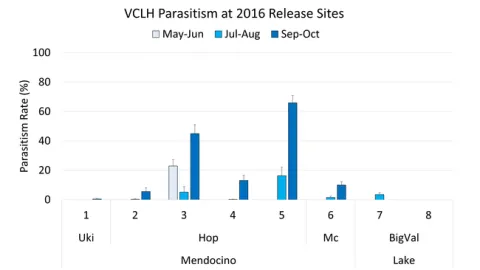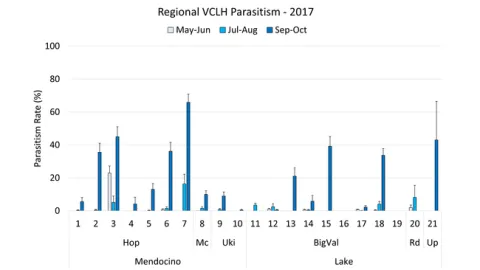Leafhopper Parasitism Update - July 2018
On July 9 we surveyed parasitism of Western grape leafhopper (WGLH) and Virginia creeper leafhopper (VCLH) across 9 sites in Mendocino and Lake counties (Fig. 1). WGLH parasitism was fairly consistent (average 38%), but there was little to no VCLH parasitism (average 0.6%). These trends are in line with data from previous survey years (2014-2017).

Figure 1. Leafhopper parasitism across Mendocino and Lake counties on July 9, 2018. Parasitism of WGLH was fairly consistent while there was little to no VCLH parasitism.
Anagrus daanei is the key parasitoid of VCLH and is known to attack the eggs of both WGLH and VCLH. While this parasitoid species is present in the North Coast, they appear to only be attacking WGLH eggs. Even when isolated with VCLH eggs, the A. daanei from the North Coast will not attack it.
Surveys across northern California in 2014 led to the identification of a population of A. daanei in the Sacramento Valley that do attack VCLH. Morphological and molecular comparisons of the A. daanei from the North Coast and Sacramento Valley indicate that these are not separate species, but rather just separate populations with different host preferences.
From 2015-2017 a large-scale A. daanei rear-release program resulted in the introduction of more than 30,000 parasitoids across multiple regions of Mendocino and Lake counties. In some cases these introductions led to locally increased parasitism of VCLH, but results were inconsistent (Fig. 2). At present the rear-release program is inactive, but we are maintaining a colony of the Sacramento Valley A. daanei at UC Berkeley.

Figure 2. Parasitism of VCLH was inconsistent in vineyards where A. daanei was released. (Uki = Ukiah, Hop = Hopland, Mc = McDowell Valley, Bigval = Big Valley)
Annual trends indicate that VCLH parasitism is increasing across the region, albeit mostly at the end of the season (Fig. 3). What's interesting is that in some cases late season VCLH parasitism is occurring at sites where no parasitoids were introduced. We are currently conducting a more detailed genetic analysis of the A. daanei recovered from these late season VCLH in order to see if we can differentiate between the local and introduced parasitoids.

Figure 3. Parasitism of VCLH tends to increase in the late season, regardless of whether or not A. daanei were released. (Hop = Hopland, Mc = McDowell Valley, Uki = Ukiah, BigVal = Big Valley, Rd = Red Hills, Up = Upper Lake)
In summary, parasitism of VCLH appears to be in flux and is certainly not consistent at this point. As such, growers need to remain vigilant. In the absence of adequate biological control, early and thorough monitoring of leafhoppers is essential. When populations surpass economic thresholds, well-timed sprays in the early season are critical to control VCLH populations, especially in organic and biodynamic vineyards.
Many thanks to Ryan Keiffer (UCCE Mendocino) for carrying out this parasitism survey.
